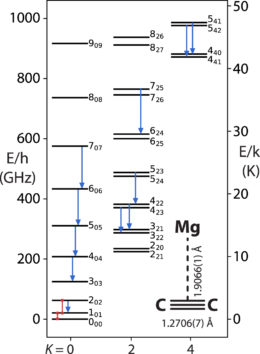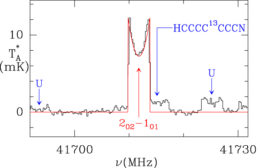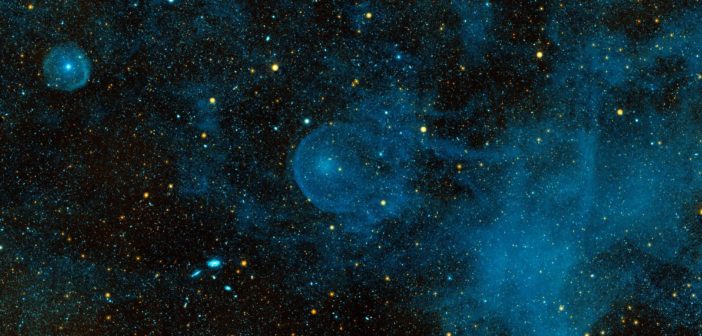The sooty cloud surrounding the carbon star CW Leonis is known to contain more than 50 types of molecules, and the remaining unassigned spectral lines hint that many more molecules are present. Can a laboratory study of a metallic molecule help us identify some of these mystery spectral lines?
Searching Space for Chemical Compounds

Another view of CW Leonis, this time from the Hubble Space Telescope. This image highlights the dusty layers shed by this evolved star. [ESA/Hubble & NASA, T. Ueta, H. Kim; CC BY 4.0]
One of the best sites to study extraterrestrial molecules is in the dusty shroud and outflows of the star CW Leonis, also known as IRC+10216. CW Leonis is a carbon star: a supergiant star with a high abundance of carbon in its atmosphere. Among CW Leonis’s many molecules are metal-containing species like silicon dicarbide (SiC2), leading researchers to wonder if similar molecules might be responsible for any of the remaining unidentified lines in CW Leonis’s spectrum.

Summary of the known transitions and energy levels for magnesium dicarbide, as determined from laboratory and astrophysical observations. [Changala et al. 2022]
Making Magnesium Molecules
A team led by Bryan Changala (Center for Astrophysics ∣ Harvard & Smithsonian) focused their search on magnesium dicarbide (MgC2). Changala and collaborators considered it likely that CW Leonis’s dusty shroud contains magnesium dicarbide because it’s chemically similar to the already-discovered silicon dicarbide, and many other magnesium-containing molecules have been found there.
How do you determine if a star’s spectral lines are due to a particular molecule, though? In order to be confident that we’ve discovered a molecule in space, we need to know its spectrum, which is best determined by studying the molecule in a lab. In the case of magnesium dicarbide, researchers have used quantum mechanical models to predict the molecule’s spectrum but had never confirmed it in a lab.
Changala and coauthors combined magnesium atoms with acetylene molecules, which are made of carbon and hydrogen, hoping to synthesize magnesium dicarbide. The team successfully matched a spectral line from their sample to a line predicted by quantum mechanical models and performed additional tests to ensure that the molecule they created was actually magnesium dicarbide.
Seeking a Spectral Match

Example of a spectral line attributed to magnesium dicarbide. The fitted line profile is shown in red, and the blue “U” indicates unidentified lines. [Adapted from Changala et al. 2022]
What does the discovery of magnesium dicarbide in CW Leonis’s spectrum tell us? By comparing the abundance of magnesium dicarbide in the star’s surroundings with the abundances of other magnesium-containing molecules, researchers might be able to glean how these molecules are made. Additionally, these observations may help us understand how metals affect the chemistry of carbon-rich environments like the surroundings of carbon stars, helping to lift the veil on these dusty objects.
Citation
“Laboratory and Astronomical Discovery of Magnesium Dicarbide, MgC2,” P. B. Changala et al 2022 ApJL 940 L42. doi:10.3847/2041-8213/aca144
